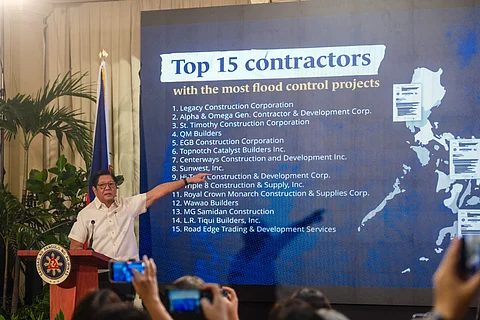Hundreds of billions of pesos are funneled yearly to 15 contractor firms which corner most of the flood control projects in the country, President Ferdinand Marcos Jr. said yesterday. Five of the companies have multiple contracts across the country.
“Five of these contractors have projects in almost the entire country. These are the ones that immediately pop up that I think we should take a look at,” the President said as he presented a list of the firms.
In his presentation, the five that stood out were Legacy Construction Corp., Alpha & Omega General Contractor & Development Corp., St. Timothy Construction Corp., EGB Construction Corp., and Road Edge Trading & Development Services.
The contractors that cornered about P100 billion, or roughly 20 percent, of the total flood control budget were Legacy Construction Corporation, Alpha & Omega General Contractor & Development Corporation, St. Timothy Construction Corporation, QM Builders, EGB Construction Corporation, Topnotch Catalyst Builders Inc., Centerways Construction and Development Inc., Sunwest Inc., Hi-Tone Construction & Development Corporation, Triple 8 Construction & Supply Inc., Royal Crown Monarch Construction & Supplies Corporation, Wawao Builders, MG Samidan Construction, L.R. Tiqui Builders Inc., and Road Edge Trading & Development Services.
According to Marcos, there were 6,021 projects worth more than P350 billion, but the type of flood control structures built, repaired, or rehabilitated were not specified.
The President highlighted that 20 percent of the total budget, or P100 billion, that the government has spent so far on flood control projects went to the 15 contractors.
“Five of these 15 contracts have projects in almost all the regions nationwide. The justification for choosing these contractors was to say, ‘let’s give a chance to local contractors so they can have work,’” he said.
Marcos said local contractors are easier to deal with because they communicate directly with local officials.
“Again, my experience as governor is that as much as possible, we try to do it locally. Because you can ask them to be quicker; you can say, ‘work faster, why is it unfinished?’ You have some influence over the thing, but that one, that for me was the one that stood out very much,” he said.
Meanwhile, Marcos launched a website where users can track flood control projects in their localities.
Through this platform, the public can engage with the government by filing a complaint or giving commendations for accomplished projects.
Lacson’s suggestion OK
The President agreed with Senator Panfilo Lacson’s suggestion to tap wealthy Filipinos to solve the flooding problem, but he said he will not require them to help.
“You know, you don’t look a gift horse in the mouth. If they are willing to help, they will help. And this is not anything new. The so-called taipans of the country are willing to offer when we want to do something. That’s why they help a lot,” he said.
Identical costs impossible
Several flood control projects were located in different places but they had the same exact contract costs. That could mean the same designs, materials, and lengths were used despite differences in location or terrain.
“I think anybody who works in either the private or public sector, if you say there are 50 projects all costing the same, P150 million, that’s impossible,” he said.
“It is impossible for one barangay, even if they are the next barangay, to have the exact same project to the exact same amount with the exact same contractor. It’s impossible. And that is why that is a significant finding that we have made,” he added.
Region 3, the National Capital Region, and Region 5 had the most projects with the highest spending.
In Region 3, there were 1,617 projects costing P98.01 billion; NCR had 1,058 projects costing P52.57 billion; and Region 5 had 866 projects costing P49.61 billion.
“We looked at the regions with the most projects. And this is what came out. So that’s something we need to explore further. Like the NCR, that makes sense because there is the flood problem. But we’re still looking into it. Then, Region 3, well, they’re flood prone. But let’s see why, as opposed to other places that have known, that are also flood prone,” he said.
Marcos noted there were flood-control projects in areas that are not prone to flooding.
“I think you will notice they don’t necessarily match. This side and that side don’t necessarily match,” Marcos pointed at the wall of his presentation.
“Now, I’m sure there are explanations for that. We will have to study it further. But you would intuitively say that projects that are in the areas, rather than the provinces or regions, whatever you want to do, whatever is flood-prone, should have the most projects, right? But that’s not the case, that’s why we have to study it well and how it happened.”
Not pointing fingers
Marcos said that no one should be pointing fingers at the projects, as it will be “premature” to name names until they know what is going on.
“Go out there, take a look. Talk to the people. We need to hear from everyone. And that’s, that’s something that I think we can all play a part in,” he said.
The President was aware that each complaint will need to be validated, as bad actors may report their bidding opponents out of spite.
“I know that once this comes out, there would be various complaints, with some justifiable and some not, due to politics, bidding loss, the usual thing. But we will still go through every single one. And we still have to see what is, what is credible and what needs to be acted upon,” he said.
“So let’s be fair to everyone and not say this and that, so someone would be cut off from their work unless we have a good idea of what went wrong,” he added.


